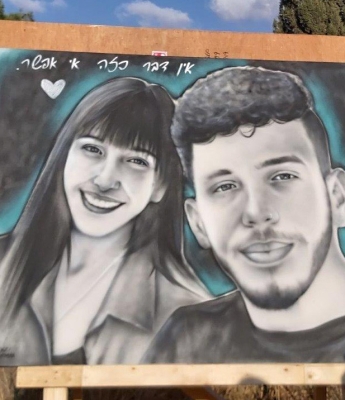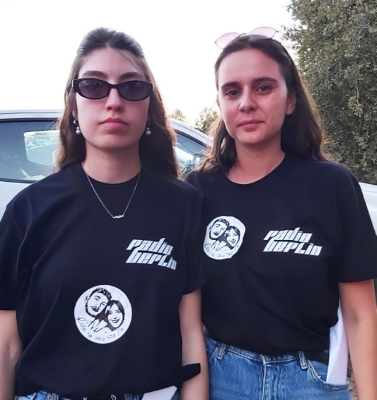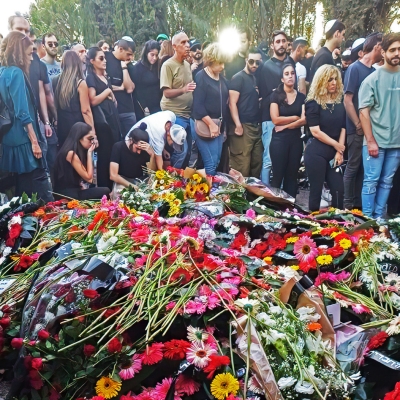Valley of Tears - Noa and Gidi Chiel
 Mourners pass large black and white portrait of Noa and Gidi Chiel, the work of Israeli artist Benzi Brofman
Mourners pass large black and white portrait of Noa and Gidi Chiel, the work of Israeli artist Benzi Brofman
Text and Photos: Lydia Aisenberg
A brother and sister who loved music, dance and life itself to the fullest, brutally murdered by Hamas terrorists during the October 7th dawn attack on thousands of revellers at the Supernova Festival near Kibbutz Reim, were buried this afternoon – Wednesday, 18th October – side by side in the cemetery of their home community of Ahuzat Barak near the town of Afula in the Jezreel Valley.
Thousands of Israelis, many coming from afar, crowded the small Ahuzat Barak cemetery that nestles in a tree-lined hollow surrounded by recently ploughed agricultural fields of the nearby kibbutzim, as 27-year old Noa Chiel and her 24-year old brother Gidi were laid to rest. A huge black and white painting of the siblings towered above the mourners standing shoulder to shoulder inside and around the perimeter of the cemetery.
Last week Noa and Gidi's younger brother, 17-year old Yonatan Chiel, made a heart-breaking plea on Tik Tok as the Chiel family desperately tried to trace the missing siblings and their unaccounted-for friends, following the barbaric attack on the music-loving and peace-searching Supernova techno crowd at Reim.
Five other Ahuzat Barak residents also lost their lives in the Supernova festival carnage.
Hundreds of the mourners, including Noa and Gidi's parents, brother Yonatan and extended family, all wore identical black T-shirts with a logo designed by Gidi for Radio Berlin Tel Aviv, a company organizing techno music events.
The black shirts, with Radio Berlin printed on the front left hand side and on the back, a wavy lined purple Smiley that isn't exactly smiling, stood out as the young mourners stood in clusters, clinging to each other for support, interspersed among the scores of young and not-so-young uniformed and heavily armed soldiers and civilians of all ages who attended the funeral in what has become a valley of tears and torn hearts.
Many had placed black and white stickers on their black shirts with the images of Noa and Gidi, and some of the soldiers had pinned them to their uniforms.
I have never met Noa or Gidi, their parents or brother Yonatan, but I have known and in the past worked for many years with their paternal grandmother Eva Chiel.
Like myself, Eva made aliyah from Sweden in the 1960s, became a member of Kibbutz Sarid, situated exactly opposite my own kibbutz, Mishmar HaEmek in the Jezreel Valley. For many years, we were both responsible for the welfare and organization of educational seminars for hundreds, actually thousands, of young people from all over the world, who volunteered on kibbutzim from the late 1960s through to relatively recent times.
Hundreds of those former kibbutz volunteers, 350,000 or more spread out over a 40-year-period, eventually settled in kibbutzim or elsewhere in Israel, and thousands more who returned to their countries of origin or continued their travels around the world, maintain close ties to this day with members of the kibbutzim where they volunteered.
Over the past week I have received hundreds of emails, WhatsApp and Messenger messages from former Jewish and mostly non-Jewish overseas volunteers and ulpan students, many of whom had lost contact. They are all horrified, concerned and care deeply and ask what, if anything, they can do to help.
In my own kibbutz at the moment we have over 400 members of Kibbutz Nachal Oz staying with us, and over 100 other evacuees who have close friends or family in Mishmar HaEmek.
Our dining-room notice board is full of death announcements for Nachal Oz members and their families who were murdered in their own home or elsewhere in their kibbutz. In parts of Mishmar HaEmek notices are pinned to trees, giving directions as to where shiva is being held for those lost and identified.
An Israeli flag flies at half mast on the central lawn of the kibbutz as we try to embrace the Nachal Oz survivors amongst us, and to support and help them in every way to rebuild their community here until they can eventually, hopefully for those that want, be able to emotionally and physically return and rebuild their once beautiful kibbutz of Nachal Oz.










Comments